Last Updated on April 17, 2023
April, May and Juny in Germany are rich in various holidays and additional days off. Especially happy are Bavaria and Baden-Wurttemberg. They have still additional Pentecost school holidays.
Other German holidays
Feasts in Germany. December – January
Carnival vocabulary
Saint Martin Feast. Songs
DIY lanterns for Saint Martin feast. 4. “Drums” and “Houses”
What is Besen?
Easter in Germany
Easter (Ostern) is the main Christian holiday of the church year. It’s not as commercialized as Christmas, although you can’t say stores aren’t trying to make it that way too. The main mystery for me is why the hare should bring gifts for Easter. By the way, let’s see what the hare is all about.
So, officially, the weekend is for believers to go to church, pray and fast. The most important days are Friday (Karfreitag, Kar means mourning) and Sunday (Ostersonntag). Friday is a mourning day for Christ who died on the cross, a strict fast. Sunday is the celebration of the resurrection of Christ. The word Ostern is associated with an old word meaning dawn.
Gründonnerstag – Maundy Thursday, the day of the Last Supper – is not a day off, but this is already the beginning of the celebration, preparation for it. After evening mass, fasting should begin. Maundy Thursday is called green for unclear reasons, but for a very long time (this name has been already known since the 12th century) and only in German-speaking countries. Four explanations are the most popular, three of them are religious notions, and the fourth one seems more natural to me: since Easter picks up the traditions of pagan celebrations of the beginning of spring, and by the time it is held, the first plants are already appearing.
In reality, hardly a fifth of the inhabitants of Germany visit church, the rest prefer to visit relatives or warm seas.
In the traditions of Easter, there are many pagan customs, it was primarily a celebration of the beginning of spring.
Easter eggs
Eggs have been dyed since ancient times, including by the Egyptians. For Christians, associating eggs with Easter was very practical and was also a consequence of fasting: eggs could not be eaten, like meat, therefore, they accumulated and had to be quickly eaten with the end of fasting.
In Germany, Easter eggs are dyed and hung at springs – this is called Osterbrunnen. In houses, it is customary to decorate trees or cut branches, more often birch (Osterstrauß), with painted eggs.

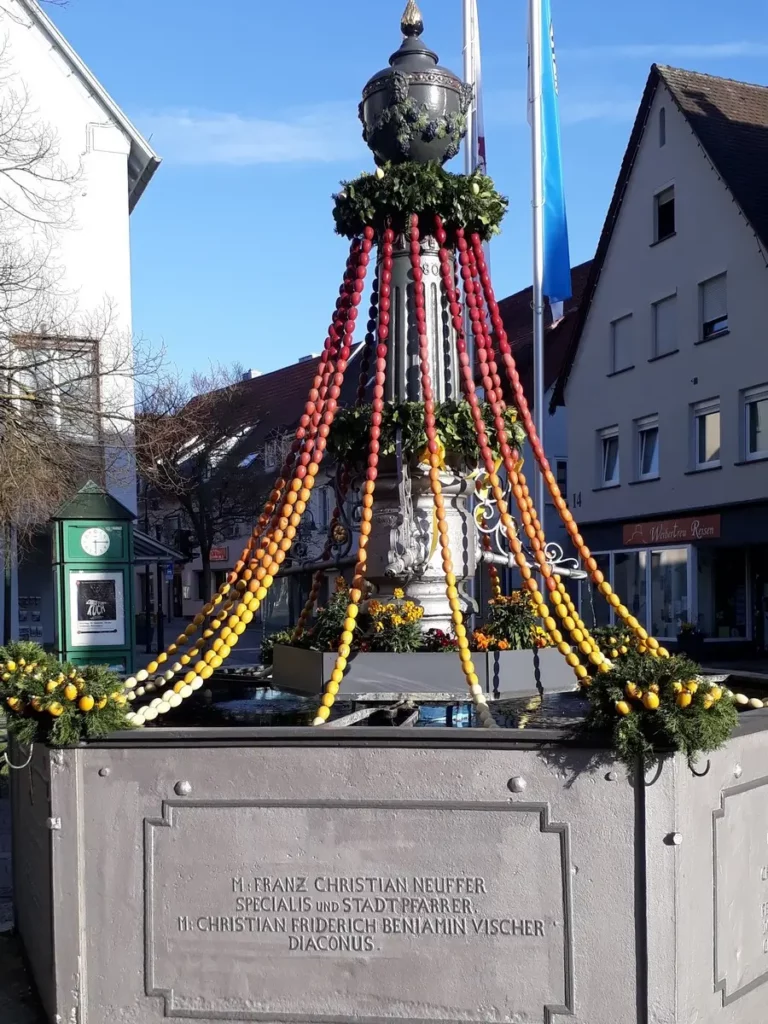
The Lusatian Sorbs (a region in the Spreewald in Brandenburg and northern Saxony) gave the tradition a special meaning. Here, eggs are artistically painted, as is done by other Slavs, using various techniques and traditional colors and patterns that have a special meaning. They also play egg rolling (Waleien).
What to see in Spreewald
Read about traditional clothing of the Lusatian Sorbs
In Drebkau you can see more than 3000 eggs from 52 countries. Lübbenau hosts an Easter egg fair and other cities host Easter markets.
Another Easter egg museum is located in the Swabian Sonnenbühl (in the Swabian Alb).
Oberlausitz hosts also horse processions for Easter (Osterreiten).
Easter hare
And what about the hare? The hare brings eggs and hides them. Why – no one knows. It is only known that this tradition is old and was mentioned in the 17th century.
The hare is one of the Christian symbolic animals, apparently thanks to a mistranslation of one of the Christian texts. But why he suddenly began to hide eggs for children in the Alsace region and adjoining Germany, God knows. After chocolate became much more affordable thanks to sugar from sugar beets, the production of chocolate bunnies and eggs quickly grew, and the tradition spread beyond the original territory.
The children look for eggs on Sunday morning.
Traditional Easter food in Germany
In addition to chocolate eggs and hares, boiled eggs, there are also pastries in the form of hares and lambs from yeast dough. Lamb is from the Jewish tradition. After all, Jewish Passover celebrates the exodus of the Jews from Egypt, when God recognized houses with Jewish children by the blood of the lamb on the doors and did not kill them.
They usually bake on Easter Saturday. They also make Osterbrot – a German version of Easter bread. Osterbrot in Germany is also brought to the sick and old (as they do with Christmas cookies).
German Christmas cookies for beginners.
A classic recipe for Easter bread, differing from source to source in the amount of sugar (maybe a little less), almonds (also a little less) and raisins (from 100 to 250 gr). Some recipes also use soft cottage cheese.
- 500g flour (Mehl)
- 250 ml milk (Milch)
- 1 yeast cube (1 Würfel Hefe)
- 100g butter (Butter)
- 80g sugar (Zucker)
- 1 egg (Ei)
- 100g chopped almonds (gehackte Mandeln)
- 1 spoonful of grated lemon
- 250g raisins (Rosinen or Sultaninen)
- 1 a pinch of salt (Prise Salz)
On the festive table they put all the same lambs and hares in the form of roast and stew, smoked pork Osterschinken. The beginning of spring also means green additions to the table: herbs and spinach.
You can often hear the expression Osterbrunch – this is a festive breakfast for Easter.
Maifest
Early May is associated with the traditional folk holiday of the spring – Maifest. It is celebrated most often on May 1 or on the first weekend of May.
In many regions, this holiday has lost much of its significance. And from it remained mainly the custom of setting up a May tree (Maibaum). But in some places the old version also remained – with the May dance or ball (Tanzen im Mai), with the choice of the May queen or the king and queen.
The May tree is erected at the beginning of the holiday or in the evening before it. The origin of the tradition, presumably, dates back to the time of paganism. Later it was Christianized, associated with the Trinity or the Mother of God.
Since the May holiday is preceded by Walpurgis Night (Walpurgisnacht, April 30) with rampant evil spirits, dancing and a fire, the installation of a May tree may mean the triumph of a good.
May tree is a decorated tree or tree trunk. Each village decorates it differently.
We have a trunk cleared of bark (20 meters high) with a wreath-wheel and a fir tree on top. The installation of the tree takes place solemnly. The representatives of the city in historical costumes, social clubs, orchestra march in procession.
In some places, the custom of stealing the May tree from a neighboring village has also been preserved, so young people have to protect it. The stolen tree is returned for food/drink offerings. The tree stands until June 1.
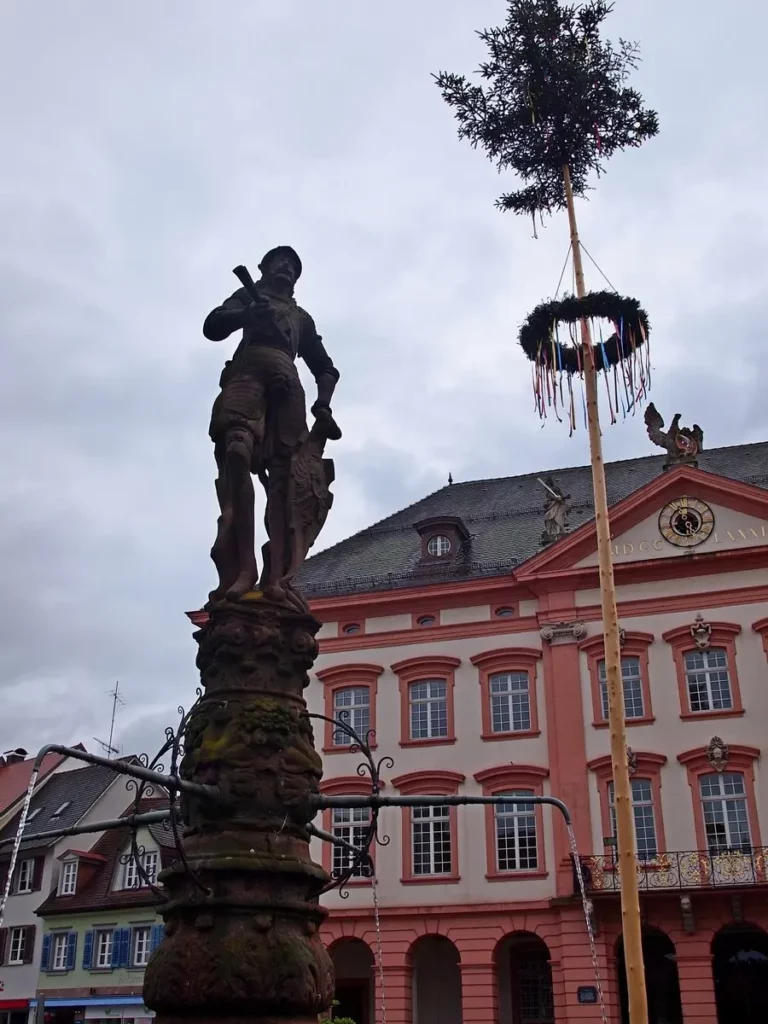
In some regions, the custom has also been preserved to bring small May trees to the homes of unmarried girls or girlfriends / brides.
1th May
1th May – International Workers’ Day, which is also celebrated in other European countries.
But in Germany, this holiday has its own peculiarity. In large cities, demonstrations are held not so much by workers as by left and right extremists. As a rule, these demonstrations end in clashes with the police. Therefore, on this day it is better to stay at home or spend it in nature.
Mother’s day (Muttertag)
Mother’s Day is celebrated in Germany on the second Sunday of May. This holiday came from America and has been celebrated in Germany since 1923.
On this day, flower shops are allowed to work, despite the Sunday. Mothers are given flowers, small gifts, children make crafts, bake pies or cookies.
Father’s Day (Vatertag)
Father’s Day coincides with the public holiday of the Ascension of the Lord (Christi Himmelfahrt).
Vatertag also came to Germany from America, but the modern form of celebrating Men’s Day has existed since the end of the 19th century.
Its meaning is simple and unpretentious: get together with a male company, go to nature or on an “excursion” with a visit to a pub and drink the maximum amount of alcohol. According to statistics, alcohol consumption on this day reaches its maximum values of the year.
On this day, it is better to avoid popular local recreation areas, well-trodden bicycle roads. They are filled with the rumbling of carts (Bollerwagen – “rattling cart”) stuffed to the top with beer, loud music, parties in beer gardens. And also, you should not go for a walk to such places the next day – empty bottles and garbage have not yet been removed.
Pentecost (Pfingsten)
The Pentecost is a public holiday, but is celebrated only by very religious people. For the rest, this is an opportunity for relaxation, while in the south it is also a school vacation.
Fronleichnam
The Feast of Corpus Christi (Fronleichnam) is also part of the Pentecost holidays. It is one of the most important Catholic holidays throughout the year. In some federal states in Germany, this is an official holiday, as in all of Austria.
A distinctive feature of Fronleichnam is the colorful processions. In Austria they are more common, in Germany – in cities where there are some special shrines or traditions.
Since we usually use the opportunity to have a travel without competitors on Trinity, my photos of the procession are Austrian, not German. We were in Zell-am-See, but I would like to see the procession in Hallstatt or on Lake Traun sometime, where it passes on decorated boats.
The essence of the holiday is short: at the Last Supper, Christ identified bread with his body, and wine with blood, from where comes the sacrament. At the feast, teenagers receive sacrament for the first time.
The celebration in Zell am See began with a mass that lasted a little less than an hour. The tourists, meanwhile, were languishing in the sun, since the start time of the mass was known, and the procession was supposed to be “at the end.”
Finally, the characters began to line up: musicians, military and other similar organizations (voluntary fire department, huntsmen, the Red Cross and others whom I did not identify), then ladies in costumes – either the local historical society, or local cream of society. Then everyone else, but many of them in traditional costumes: women in dirndls, men in leather shorts.

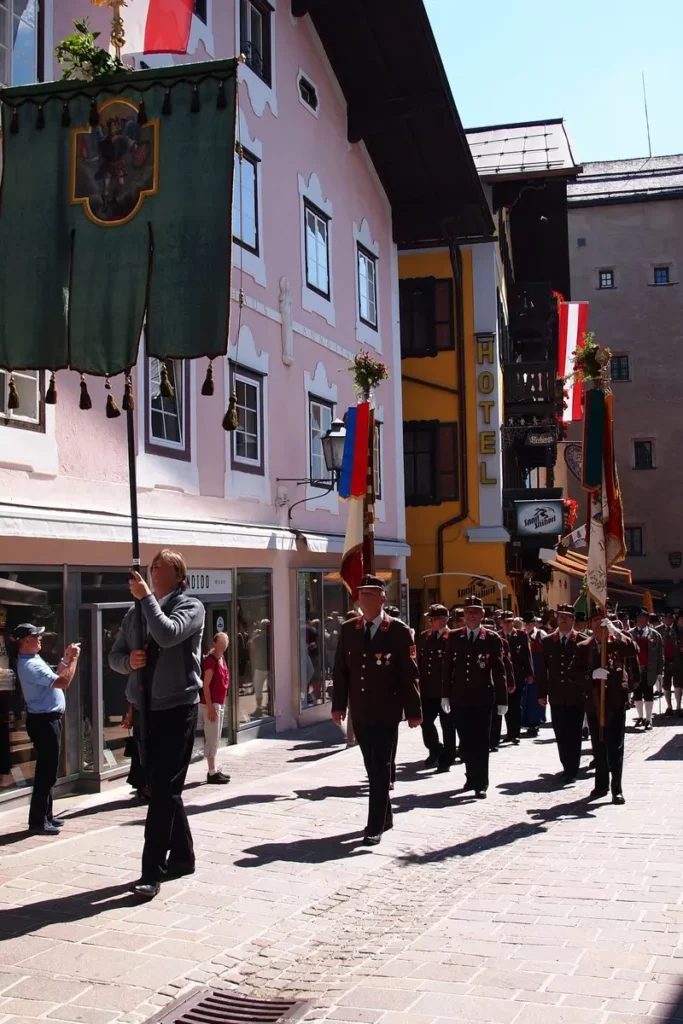

Follow me
Everyone comes with pennants of their organizations and banners, they carry statues and crosses. Children scatter rose petals and jingle bells. During the procession, prayers are said into the microphone. When the procession reaches a certain place (chapel, church, street icon – as is customary in this city), the priest reads the text and sings psalms. So they go around half the city – our procession returned back an hour and a half later and at the end they still fired from guns.
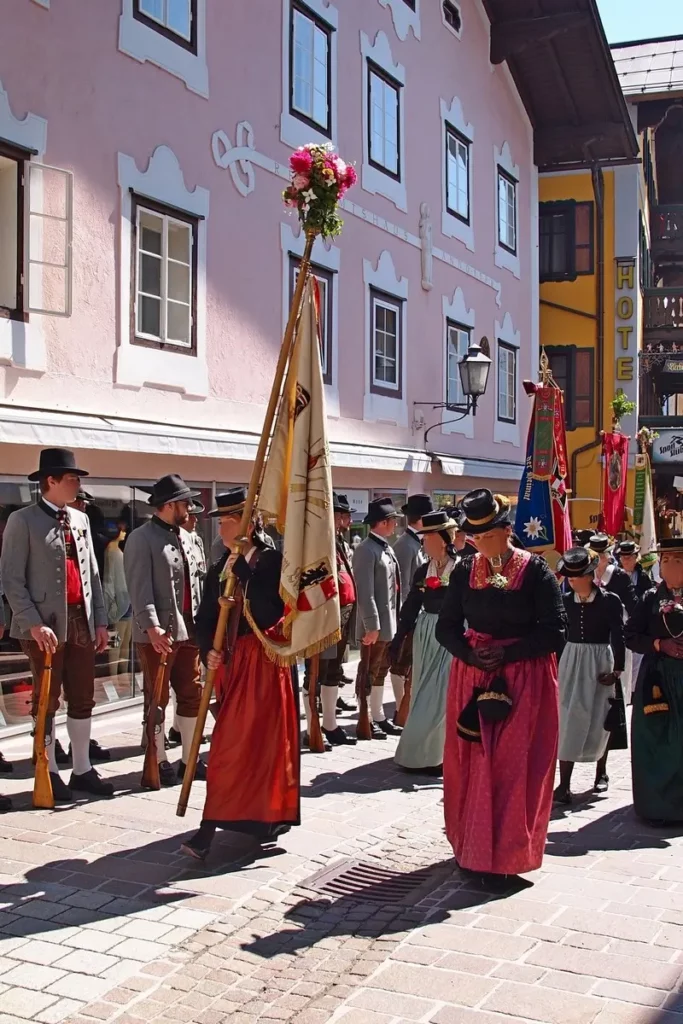



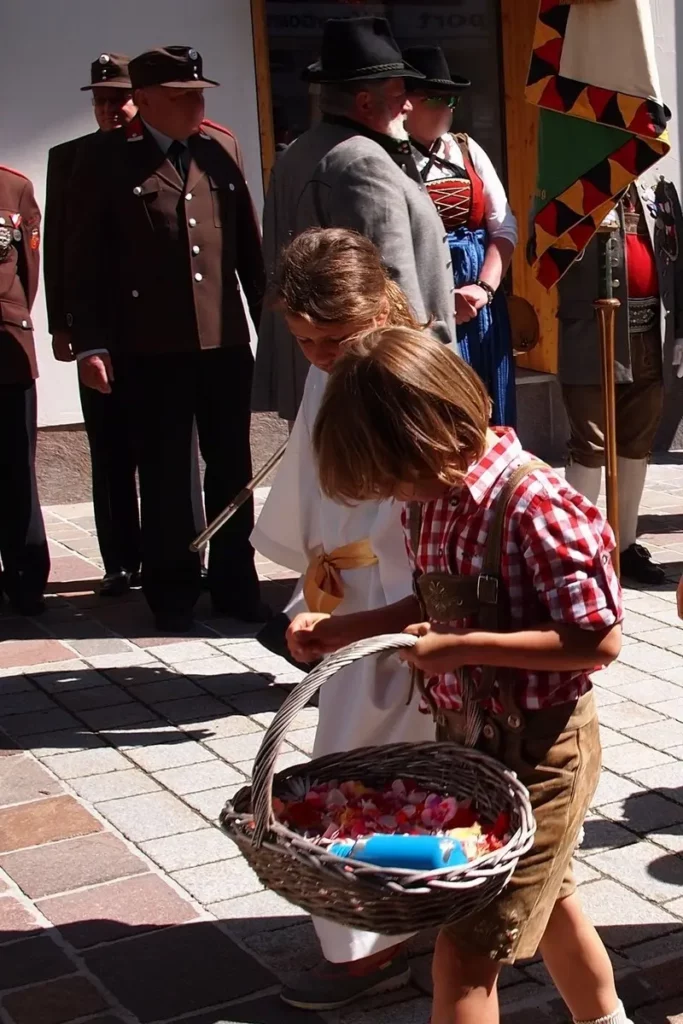
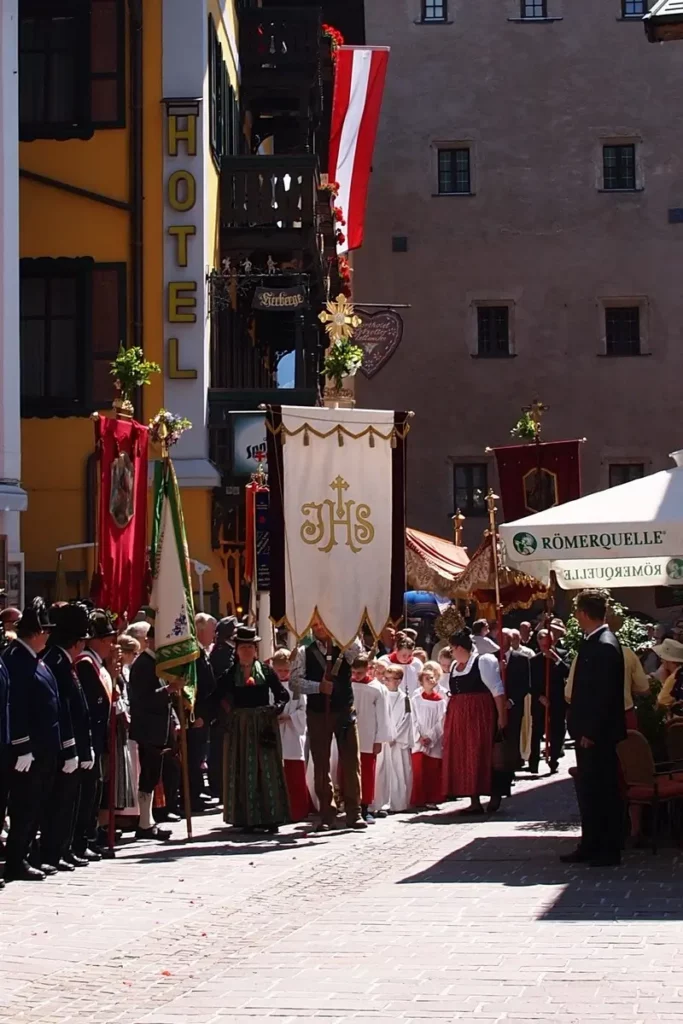
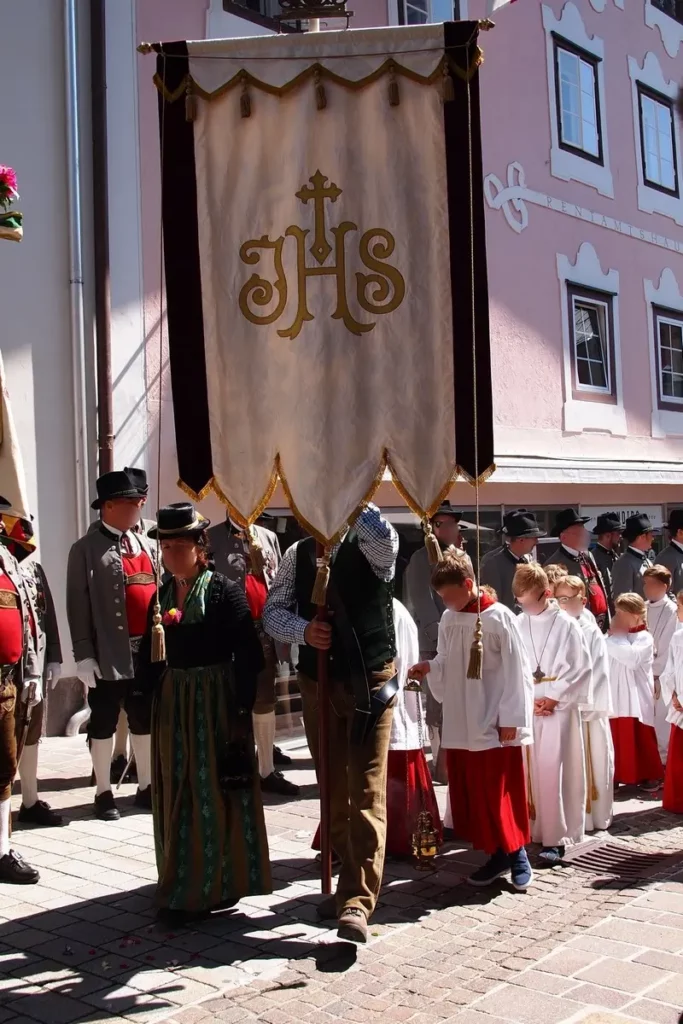
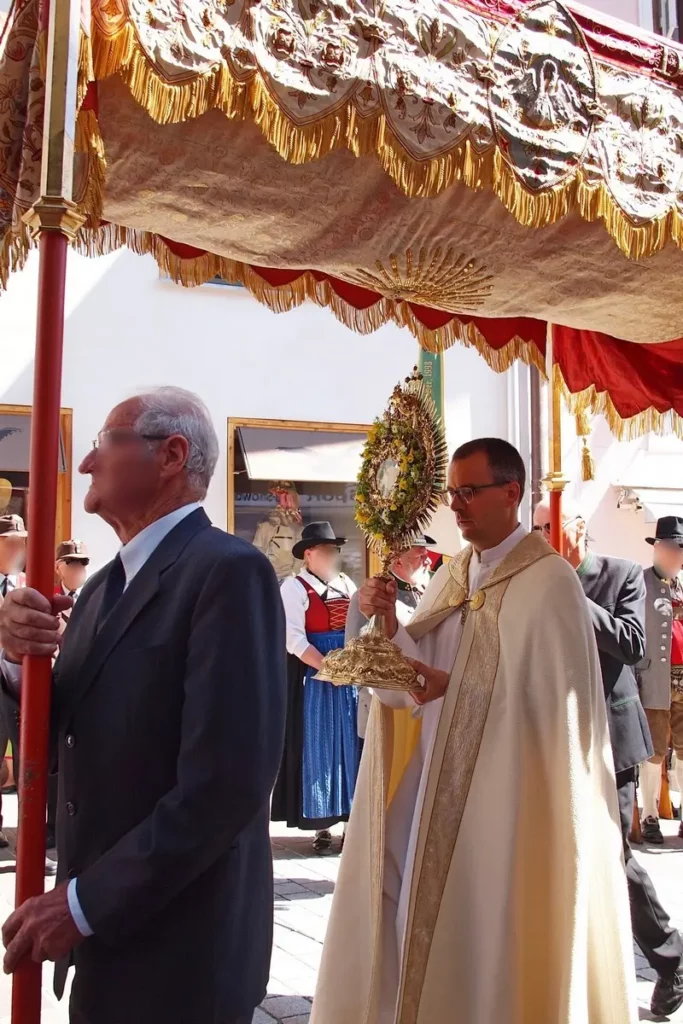
Other holidays in Germany
#culture
#traditions
Do you enjoy the site without cookies and maybe without ads? This means that I work for you at my own expense.
Perhaps you would like to support my work here.
Or Cookie settings change: round sign bottom left

